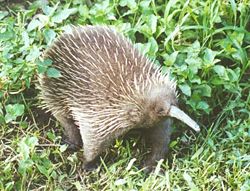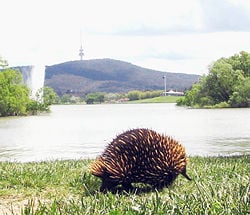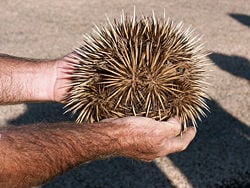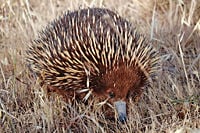Difference between revisions of "Echidna" - New World Encyclopedia
Rick Swarts (talk | contribs) (→Media) |
Rick Swarts (talk | contribs) |
||
| Line 41: | Line 41: | ||
Echidnas are covered with coarse [[hair]] and [[spine (biology)|spines]]. Superficially, they resemble the [[anteater]]s of South America, and other spiny mammals like [[hedgehog]]s and [[porcupine]]s. | Echidnas are covered with coarse [[hair]] and [[spine (biology)|spines]]. Superficially, they resemble the [[anteater]]s of South America, and other spiny mammals like [[hedgehog]]s and [[porcupine]]s. | ||
| − | Echidnas have elongated and slender snouts that have the functions of both the mouth and nose. They have very short, strong [[Limb (anatomy)|limb]]s with large [[claw]]s and are powerful diggers. Echidnas have a tiny [[mouth]] and a toothless [[jaw]]. They feed by tearing open soft logs, [[anthill]]s and the like, and use their long, sticky [[tongue]] which protrudes from their snout, to collect their prey. The [[Short-beaked Echidna]]'s diet consists largely of [[ant]]s and [[termite]]s, while the three extant ''Zaglossus'' species typically eat worms and insect larvae. The long-nosed echidna has tiny spines on its tongue that helps capture its meals. | + | Echidnas have elongated and slender snouts that have the functions of both the mouth and nose. They have very short, strong [[Limb (anatomy)|limb]]s with large [[claw]]s and are powerful diggers. Echidnas have a tiny [[mouth]] and a toothless [[jaw]]. They feed by tearing open soft logs, [[anthill]]s and the like, and use their long, sticky [[tongue]] which protrudes from their snout, to collect their prey. |
| + | |||
| + | The [[Short-beaked Echidna]]'s diet consists largely of [[ant]]s and [[termite]]s, while the three extant ''Zaglossus'' species typically eat worms and insect larvae. The long-nosed echidna has tiny spines on its tongue that helps capture its meals. The diet of the western long-beaked echidna (''Zaglossus bruijni'') is almost exclusively [[earthworm]]s, although they will also eat termites and other insect larva (Cross 2002). The earthworms are positioned to go front first into the snout, by the echidna wrapping its powerful tongue around the front of the worm (Cross 2002). | ||
The echidna female lays a single soft-shelled, leathery [[egg (biology)|egg]] twenty-two days after mating and deposits it directly into her pouch. Hatching takes ten days. The young echidna, called a [[puggle]] as with the platypus infant, then sucks [[milk]] from the [[lactiferous duct|pore]]s of the two [[Mammary gland|milk patches]] (monotremes have no [[nipple]]s) and remains in the pouch for forty-five to fifty-five days, at which time it starts to develop spines. The mother digs a nursery burrow and deposits the puggle, returning every five days to suckle it until it is weaned at seven months. | The echidna female lays a single soft-shelled, leathery [[egg (biology)|egg]] twenty-two days after mating and deposits it directly into her pouch. Hatching takes ten days. The young echidna, called a [[puggle]] as with the platypus infant, then sucks [[milk]] from the [[lactiferous duct|pore]]s of the two [[Mammary gland|milk patches]] (monotremes have no [[nipple]]s) and remains in the pouch for forty-five to fifty-five days, at which time it starts to develop spines. The mother digs a nursery burrow and deposits the puggle, returning every five days to suckle it until it is weaned at seven months. | ||
| Line 79: | Line 81: | ||
''Zaglossus'' are a popular food source. (Cross 2002; Augee 1993; Walker 1991). However, hunting and habitat loss is causing population declines. | ''Zaglossus'' are a popular food source. (Cross 2002; Augee 1993; Walker 1991). However, hunting and habitat loss is causing population declines. | ||
| − | |||
| − | |||
| − | |||
| − | |||
| − | |||
| − | |||
[[Image:French Island Echidna.ogg|none|thumb|320px|A [[French Island National Park|French Island]] echidna building a defensive burrow (0:43s)]] | [[Image:French Island Echidna.ogg|none|thumb|320px|A [[French Island National Park|French Island]] echidna building a defensive burrow (0:43s)]] | ||
| − | |||
| − | |||
==See also== | ==See also== | ||
| Line 105: | Line 99: | ||
* Shultz, N. 2007. [http://environment.newscientist.com/article.ns?id=dn12838 Exhibitionist spiny anteater reveals bizarre penis]. ''New Scientist''. Retrieved May 9, 2008. | * Shultz, N. 2007. [http://environment.newscientist.com/article.ns?id=dn12838 Exhibitionist spiny anteater reveals bizarre penis]. ''New Scientist''. Retrieved May 9, 2008. | ||
| + | |||
| + | * Augee, M. L. 1993. Echidnas of Australia and New Guinea. New South Wales University Press, Australia | ||
| + | |||
| + | * Cross, D. 2002. [http://animaldiversity.ummz.umich.edu/site/accounts/information/Zaglossus_bruijni.html ''Zaglossus bruijni'' (western long-beaked echidna). ''Animal Diversity Web''. Retrieved May 09, 2008. | ||
| + | |||
| + | Nowak, R. M. 1991. Walker's Mammals of the World. Fifth Edition. Johns Hopkins University Press, Baltimore. | ||
==External links== | ==External links== | ||
Revision as of 21:48, 9 May 2008
| Echidnas[1] | ||||||||||
|---|---|---|---|---|---|---|---|---|---|---|
 Western Long-beaked Echidna
| ||||||||||
| Scientific classification | ||||||||||
| ||||||||||
|
Genus Tachyglossus |
Echidna (pronounced /ɨˈkɪdnə/), also known as spiny anteater, is any of the egg-laying mammals comprising the Tachyglossidae family of the order Monotremata order (monotremes), characterized by a stocky built, spiny coat, short legs with strongly clawed feet, rudimentary tail, and toothless jaw with a long and sticky tongue. There are four extant (living) species and together with the platypus, they are the only surviving monotremes.
Although their diet consists largely of ants and termites, they are not actually related to the anteater species. They live in New Guinea and Australia (including the island of Tasmania).
Description
Echidnas are monotremes; that is, they are egg-laying mammals of the order Monotremata. Monotremes represent one of the three major subdivisions of mammals. The other two groups, the marsupials and placentals give birth to live young. The key physiological difference between monotremes and other mammals is that their urinary, defecatory, and reproductive systems all open into a single duct, the cloaca. Other mammal females have separate openings for reproduction, urination, and defecation.
Like other mammals, monotremes are warm-blooded, with a high metabolic rate (though not as high as other mammals, see below); have hair on their bodies; produce milk to feed their young; have a single bone in their lower jaw; and have three middle ear bones.
Monotremes are placed in two families—with the platypus belonging to Ornithorhynchidae and echidnas in the Tachyglossidae family. There are only five extant species of monotremes, the platypus (Ornithorhynchus anatinus) and four species of echidna.
Echidnas are covered with coarse hair and spines. Superficially, they resemble the anteaters of South America, and other spiny mammals like hedgehogs and porcupines.
Echidnas have elongated and slender snouts that have the functions of both the mouth and nose. They have very short, strong limbs with large claws and are powerful diggers. Echidnas have a tiny mouth and a toothless jaw. They feed by tearing open soft logs, anthills and the like, and use their long, sticky tongue which protrudes from their snout, to collect their prey.
The Short-beaked Echidna's diet consists largely of ants and termites, while the three extant Zaglossus species typically eat worms and insect larvae. The long-nosed echidna has tiny spines on its tongue that helps capture its meals. The diet of the western long-beaked echidna (Zaglossus bruijni) is almost exclusively earthworms, although they will also eat termites and other insect larva (Cross 2002). The earthworms are positioned to go front first into the snout, by the echidna wrapping its powerful tongue around the front of the worm (Cross 2002).
The echidna female lays a single soft-shelled, leathery egg twenty-two days after mating and deposits it directly into her pouch. Hatching takes ten days. The young echidna, called a puggle as with the platypus infant, then sucks milk from the pores of the two milk patches (monotremes have no nipples) and remains in the pouch for forty-five to fifty-five days, at which time it starts to develop spines. The mother digs a nursery burrow and deposits the puggle, returning every five days to suckle it until it is weaned at seven months.
Male echidnas have a four-headed penis, but only two of the heads are used during mating, with the female reproductive tract having only two branches. The other two heads "shut down" and the other two fit, with the heads being used switched each time the mammal has sex (Shultz 2007).
The echidnas are named after a monster in ancient Greek mythology.
Taxonomy
Echidnas are classified into three genera. The Zaglossus genus includes three extant species and two species known only from fossils, while only one species from the genus Tachyglossus is known. The third genus, Megalibgwilia, is only known from fossils.
Zaglossus
The three living Zaglossus species are endemic to New Guinea. They are rare and are hunted for food. They forage in leaf litter on the forest floor, eating earthworms and insects. The species are:
- the western long-beaked echidna (Zaglossus bruijni) of the highland forests
- Sir David's long-beaked echidna (Zaglossus attenboroughi), recently discovered, prefers a still higher habitat
- the eastern long-beaked echidna (Zaglossus bartoni), of which four distinct subspecies have been identified
The two fossil species are:
- Zaglossus robustus
- Zaglossus hacketti
Tachyglossus

The short-beaked echidna (Tachyglossus aculeatus) is found in southeast New Guinea and also occurs in almost all Australian environments, from the snow-clad Australian Alps to the deep deserts of the Outback, essentially anywhere that ants and termites are available. Its size is smaller than the Zaglossus species, and it has longer hair.
Megalibgwilia
The genus Megalibgwilia is only known from fossils:
- Megalibgwilia ramsayi known from Late Pleistocene sites in Australia
- Megalibgwilia robusta known from Miocene sites in Australia
Uses
Zaglossus are a popular food source. (Cross 2002; Augee 1993; Walker 1991). However, hunting and habitat loss is causing population declines.
See also
Notes
- ↑ C. Groves, "Order Primates," "Order Monotremata," (and select other orders). Page(s) p. 1-2 in D. E. Wilson and D. M. Reeder, eds., Mammal Species of the World, 3rd edition, Johns Hopkins University Press (2005). ISBN 0801882214.
ReferencesISBN links support NWE through referral fees
- Flannery, T.F. and Groves, C.P. (1998) A revision of the genus Zaglossus (Monotremata, Tachyglossidae), with description of new species and subspecies. Mammalia 62, 367-396.
- Parker, J., "Echidna Love Trains", "Scribbly Gum" online magazine.
- Rismiller, P., "Echidnas and Goannas of Kangaroo Island", Earthwatch Institute.
- Shultz, N. 2007. Exhibitionist spiny anteater reveals bizarre penis. New Scientist. Retrieved May 9, 2008.
- Augee, M. L. 1993. Echidnas of Australia and New Guinea. New South Wales University Press, Australia
- Cross, D. 2002. [http://animaldiversity.ummz.umich.edu/site/accounts/information/Zaglossus_bruijni.html Zaglossus bruijni (western long-beaked echidna). Animal Diversity Web. Retrieved May 09, 2008.
Nowak, R. M. 1991. Walker's Mammals of the World. Fifth Edition. Johns Hopkins University Press, Baltimore.
External links
- "The Enigma of the Echidna" by Doug Stewart, National Wildlife, April/May 2003.
- Scribbly Gum - Australian Broadcasting Corporation online magazine, article "Echidna Love Trains": Echidna spotting, Trains (breeding behaviour), The amazing puggle (young), Species, Dreaming (REM sleep), Managing populations; June 2000
| ||||||||||||||
Credits
New World Encyclopedia writers and editors rewrote and completed the Wikipedia article in accordance with New World Encyclopedia standards. This article abides by terms of the Creative Commons CC-by-sa 3.0 License (CC-by-sa), which may be used and disseminated with proper attribution. Credit is due under the terms of this license that can reference both the New World Encyclopedia contributors and the selfless volunteer contributors of the Wikimedia Foundation. To cite this article click here for a list of acceptable citing formats.The history of earlier contributions by wikipedians is accessible to researchers here:
The history of this article since it was imported to New World Encyclopedia:
Note: Some restrictions may apply to use of individual images which are separately licensed.

